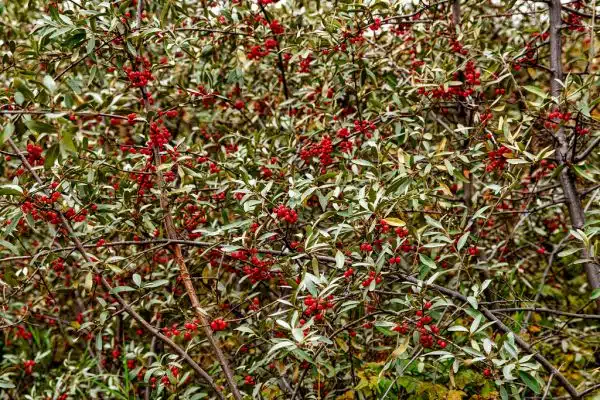Silver buffaloberry, scientifically known as Shepherdia argentea, is a deciduous shrub that is native to North America. It is a hardy plant that can withstand harsh growing conditions such as drought and poor soil fertility. The silver buffaloberry is mostly grown for its edible berries, which are rich in vitamins and have numerous health benefits.
As a horticulturist or silver buffaloberry specialist, it is essential to know the ideal growing conditions for this plant. Growing silver buffaloberry requires specific techniques and tips to ensure optimal growth and fruit production. In this article, we will explore some of the best practices for growing silver buffaloberry, including soil requirements, pruning techniques, pest management strategies, and harvesting methods. Whether you are a seasoned gardener or an amateur enthusiast looking to add this unique plant to your garden, these tips will help you grow healthy and productive silver buffaloberries.
Overview Of The Silver Buffaloberry Plant
The Silver Buffaloberry plant is a highly prized species amongst horticulturists and garden enthusiasts alike. This plant is native to the North American continent, with its presence felt from Alaska all the way down to California. The shrub grows to a height of approximately 8-12 feet and produces an abundance of small, bright red berries that are highly sought after for their medicinal properties.
The Silver Buffaloberry plant has numerous benefits that make it an ideal addition to any garden. Firstly, the plant’s attractive foliage makes it an excellent ornamental addition to any landscape. Secondly, the berries produced by this plant have high levels of vitamin C and antioxidants, making them beneficial for human consumption. Additionally, the fruit’s seeds can be used to produce oil that is rich in fatty acids and is used in the cosmetics industry.
The Silver Buffaloberry plant has many uses. Native Americans traditionally used the plant’s bark, leaves and roots for medicinal purposes such as treating digestive issues and skin ailments. Today, the berries are commonly used in jams, jellies and sauces due to their unique flavor profile. Furthermore, the oil extracted from the seeds can be used in various cosmetic products such as soaps and lotions due to its moisturizing properties. Understanding these benefits and uses of this remarkable shrub can help you make informed decisions about incorporating it into your garden or landscape design.
As we delve deeper into exploring this fascinating species of shrubbery, let us take a closer look at its climate and soil requirements.
Climate And Soil Requirements
Silver buffaloberry is a unique shrub that stands out in gardens and landscapes. To grow this plant successfully, it is crucial to choose the best locations and provide the ideal soil conditions.
Silver buffaloberry thrives in areas with a dry, cold climate. It can tolerate extreme temperatures ranging from -50°F to 100°F, making it an excellent choice for gardeners in colder regions. Moisture levels are also important as silver buffaloberry requires well-drained soil to prevent root rot. The plant can survive in various soil types such as sandy or clayey soils, but it prefers rich loamy soils that are slightly acidic.
The effects of temperature and moisture on silver buffaloberry growth cannot be overstated. High temperatures above 90°F can damage leaves and reduce fruit production, while low-temperature below -30°F can cause dieback and plant death. Insufficient moisture content in the soil can lead to stunted growth, while excessive moisture levels promote fungal diseases that attack the roots. Gardeners must monitor soil moisture levels regularly and irrigate when necessary to maintain optimal growing conditions for their silver buffaloberry plants.
To ensure successful growth of silver buffaloberry, choosing the right location is essential. A location with good air circulation and ample sunlight exposure is ideal for optimal growth and fruit production. Planting these shrubs near other nitrogen-fixing plants such as legumes can enhance their growth since they rely on nitrogen for proper development. Additionally, gardeners should consider factors such as proximity to buildings or trees that may block sunlight or affect air circulation when selecting planting locations for their silver buffaloberry shrubs.
Choosing The Right Location
When it comes to growing silver buffaloberry, choosing the right location is key. As the old saying goes, “location, location, location.” It is important to select an area with good soil drainage as silver buffaloberry does not tolerate waterlogged soils. Additionally, ensure that the site has adequate sun exposure. Silver buffaloberry thrives in full sun but can also tolerate light shade.
Soil type plays a crucial role in the successful growth of silver buffaloberry. This species can adapt to a wide range of soil types but prefers well-draining soils with a pH between 5.5 and 7.5. It is recommended to avoid heavy clay or compacted soils as they can impede root development and cause poor plant growth.
Sun exposure is another critical factor to consider when selecting a location for planting silver buffaloberry. This species requires at least six hours of direct sunlight per day to thrive, so choose a spot with plenty of sun exposure. Be mindful of any nearby structures or trees that may cast shadows on the plant during peak hours of the day.
With proper consideration of soil type and sun exposure, you can provide your silver buffaloberry plants with an optimal environment for growth and development. The next step in ensuring success is implementing appropriate watering and fertilizing techniques which we will discuss in the subsequent section.
Watering And Fertilizing Techniques
Watering and Fertilizing Techniques:
Silver buffaloberry is a drought-tolerant shrub, but it still requires adequate watering during its growing season to produce healthy foliage and fruit. Deep watering is recommended for this plant, which means that the soil should be soaked with water up to 2-3 feet deep. This encourages the roots to extend deeper into the soil where they can access moisture even during dry spells. Shallow watering may cause the roots to grow near the surface, making them vulnerable to heat and drought stress.
Apart from regular watering, silver buffaloberry also benefits from organic fertilizers. These types of fertilizers are made from natural materials such as compost, manure, or bone meal. Organic fertilizers release nutrients slowly over time, providing a steady supply of essential elements for plant growth without causing chemical imbalances in the soil. They also improve soil structure and texture, allowing better water retention and drainage. Apply organic fertilizers once a year in early spring or late fall when the shrub is dormant.
To ensure optimal growth and productivity of your silver buffaloberry shrubs, proper watering and fertilization are crucial factors that should not be overlooked. Always remember to deep water your plants regularly during their growing season and choose organic fertilizers for a sustainable approach to feeding them. With these techniques in place, you can enjoy a bountiful harvest of healthy berries that are packed with nutrients and flavor.
As we have discussed earlier on how important it is to keep silver buffaloberry well-watered and fed with organic fertilizers for optimal growth; pruning is another essential aspect that plays an equally significant role in achieving healthy shrubs. Pruning helps maintain desirable size and shape while promoting new growth by removing dead or diseased branches. It also increases air circulation within the canopy, reducing humidity levels that can lead to fungal infections. In the next section, we will delve deeper into pruning techniques that are best suited for silver buffaloberry.
Pruning For Optimal Growth
After ensuring proper watering and fertilizing techniques, it is important to consider pruning for optimal growth of silver buffaloberry. An interesting statistic about silver buffaloberry is that it is known for its dense branching structure, which allows it to be a great hedge or screen plant. Pruning can help maintain this structure and promote healthy growth.
When it comes to pruning techniques for silver buffaloberry, it is best to prune in late winter or early spring before new growth starts. This will allow the plant to recover from any potential damage caused by pruning before new growth occurs. It is also important to remove any dead or diseased branches, as well as any crossing branches that may cause damage or hinder airflow.
In terms of maintenance schedule, regular pruning should be done every 2-3 years to promote healthy growth and maintain the desired shape of the plant. However, if the plant has not been pruned in a while and requires significant shaping, more frequent pruning may be necessary. By following proper pruning techniques and maintaining a regular maintenance schedule, silver buffaloberry can thrive and provide beautiful foliage and berries for years to come.
| Pruning Techniques | Maintenance Schedule | Benefits | Potential Risks |
|---|---|---|---|
| Remove dead or diseased branches | Every 2-3 years | Promotes healthy growth | Over-pruning can cause stress |
| Remove crossing branches | More frequently if needed for shaping | Maintains desired shape of plant | Improper cuts can lead to disease |
| Prune in late winter/early spring before new growth starts | Increases airflow through plant | May require professional expertise |
As we have seen, proper pruning techniques are crucial for maintaining the health and beauty of silver buffaloberry plants. In addition to promoting healthy growth, regular maintenance schedules can ensure that the plant stays in its desired shape. However, caution must be taken when pruning to avoid over-pruning or making improper cuts that can lead to disease. In the next section, we will explore propagation methods for silver buffaloberry, allowing us to expand our knowledge and potentially add more of these beautiful plants to our landscapes.
Propagation Methods
Silver buffaloberry can be propagated through cutting and seed propagation. Cutting propagation involves taking a portion of the stem from a mature plant and rooting it in soil. To ensure success, the cutting should be taken in early spring before new growth appears. It is important to cut at an angle to increase surface area for rooting hormones, which should be applied to the cut end of the stem before planting. The cutting should be placed in well-draining soil and kept moist until roots develop.
Seed propagation is another method of propagating silver buffaloberry. Seeds should be collected from ripe berries and cleaned thoroughly before sowing. Germination rates are improved when seeds are stratified for 60-90 days in a cool, dark place prior to planting. Silver buffaloberry prefers well-draining soil with good moisture retention and partial sun exposure for optimal growth.
In conclusion, both cutting propagation and seed propagation can be effective methods for propagating silver buffaloberry. While cutting propagation may result in quicker establishment of new plants, seed propagation allows for genetic diversity among offspring. Proper care during establishment is crucial regardless of the method chosen.
Transition: Now that we have covered the various methods of propagating silver buffaloberry, it is important to address pest management strategies to ensure healthy plant growth and development.
Pest Management Strategies
Identifying pests on silver buffaloberry plants can be done by looking for signs of damage to the leaves, stems, and fruit. Controlling pests on silver buffaloberry plants can be done through the use of physical barriers, chemical controls, and biological agents. Physical barriers such as mulch, row covers, and sticky traps can be used to reduce pests on silver buffaloberry plants. Biological agents such as beneficial insects, predatory mites, and fungi can also be used to reduce pests on silver buffaloberry plants.
Identifying Pests
Picture yourself walking through a vast field of silver buffaloberry plants. The sun is shining down, casting a warm glow over the land. As you reach out to inspect the leaves, you notice small holes and discolorations on them. These are signs of pest infestation, which can significantly affect the plant’s growth and yield.
Identifying pests is crucial to effective pest management strategies for silver buffaloberry plants. There are several common pests that can cause harm to these plants, such as spider mites, aphids, and leafhoppers. It’s essential to keep an eye out for any visible signs of infestation and take appropriate action promptly.
There are two primary methods for addressing pest infestations in silver buffaloberry plants: natural remedies and chemical treatments. Natural remedies include introducing beneficial insects like ladybugs or lacewings into the ecosystem or using organic sprays made from neem oil or garlic extract. Chemical treatments involve applying pesticides, which can be harmful to both the environment and human health if not used correctly. It’s crucial to weigh the pros and cons of each method before deciding which one to use in your garden.
Controlling Pests
Pest management strategies are essential for maintaining healthy and productive silver buffaloberry plants. One of the most significant challenges that growers face is controlling pest infestations, which can significantly impact plant growth and yield. Therefore, it’s crucial to identify pests early on and take appropriate measures to control their population.
Controlling pests in silver buffaloberry plants can be achieved through natural remedies or professional pest control services. Natural remedies include introducing beneficial insects into the ecosystem, using organic sprays made from neem oil or garlic extract, or implementing companion planting techniques. These methods are safe for both the environment and human health and can effectively reduce pest populations.
Professional pest control services involve applying chemical treatments such as pesticides or insecticides. While these methods may be effective at eliminating pests quickly, they can also harm other beneficial organisms in the ecosystem and pose a risk to human health if not used correctly. Therefore, growers should carefully weigh the pros and cons of each method before deciding which one to use in their garden. Ultimately, a combination of both natural remedies and professional pest control may provide the best solution for controlling pests in silver buffaloberry plants while minimizing negative impacts on the environment and human health.
Disease Prevention And Treatment
Pest management strategies are crucial to silver buffaloberry growing success. However, it is essential to note that prevention is always better than cure. Thus, disease prevention and treatment should also be taken into account when cultivating this plant.
Prevention is the first line of defense against diseases in silver buffaloberry plants. Growers must ensure that the soil pH level is optimal for the plant’s growth as acidic soils can lead to nutrient deficiencies and susceptibility to diseases. Overwatering can also cause root rot, so proper watering practices must be observed. Moreover, growers should regularly prune their plants to promote good air circulation, which reduces the risk of fungal infections.
Despite following preventive measures, some diseases may still occur in silver buffaloberry plants. In such cases, treatment methods are necessary. A common method is chemical control, where fungicides or insecticides are used to kill or prevent the spread of pathogens or pests. Alternatively, biological control involves using natural enemies like predators or parasites to suppress pests’ populations. Other methods include physical or cultural controls such as removing infected plant parts and cleaning tools used on diseased plants.
Companion planting for silver buffaloberry is an effective way to prevent diseases while promoting growth and development. Some suitable companion plants include lupines, bee balm, and yarrow. These plants increase biodiversity within the garden ecosystem while attracting beneficial insects that aid in pollination and pest control. Additionally, companion planting can help repel harmful insects by masking the scent of desirable plants with unpleasant ones or by producing chemicals that deter pests naturally. Overall, incorporating companion planting into silver buffaloberry cultivation can enhance overall plant health and yield a bountiful harvest.
Companion Planting For Silver Buffaloberry
As gardeners, we are always looking for ways to maximize the potential of our plants. One effective method is companion planting, where different species are grown in proximity to each other to enhance growth and productivity. For silver buffaloberry, there are a variety of companion plant options that can improve its overall health and yield.
One great option for companion planting with silver buffaloberry is the nitrogen-fixing legume family. These plants have root nodules that house bacteria which convert atmospheric nitrogen into a form usable by plants. This means they can provide a natural source of fertilizer for the silver buffaloberry, reducing the need for synthetic fertilizers. Examples of legumes include clover, peas, and beans.
Another option is to plant herbs around the silver buffaloberry bush. Many herbs have natural insect-repelling properties that can help protect the silver buffaloberry from pests without resorting to harmful pesticides. Mint, thyme, and basil are all good choices for this purpose. Additionally, these herbs can be harvested for culinary use alongside the silver buffaloberry fruit.
When it comes to harvesting tips for silver buffaloberry, there are a few things to keep in mind. Firstly, it is important to wait until the berries have ripened fully before picking them. They should be a bright red-orange color and slightly soft when squeezed gently. To avoid damaging the bush or losing berries unnecessarily during harvest, it may be helpful to spread a tarp or sheet beneath the branches before picking. With proper care and attention, your silver buffaloberry bush will provide you with delicious fruit year after year!
With proper companion planting techniques in place and an understanding of when and how to harvest your crop effectively, you’ll be well on your way to cultivating healthy and productive silver buffaloberry bushes in your own backyard!
Harvesting Techniques And Timing
Companion planting is a common technique in gardening that involves planting different crops together to enhance their growth and protect them from pests. When it comes to silver buffaloberry, companion planting can be particularly helpful in promoting optimal growth and fruit production. One of the best companion plants for silver buffaloberry is clover, which helps improve soil quality by fixing nitrogen and attracting beneficial insects.
In addition to proper companion planting, there are several best practices when it comes to growing silver buffaloberry. Optimal timing is key – these shrubs should be planted in the early spring or fall, when temperatures are mild and there is plenty of moisture in the soil. They prefer full sun but can tolerate some shade, so choose a spot that gets at least six hours of direct sunlight per day.
Once your silver buffaloberry shrubs have matured and begun producing fruit, it’s important to harvest them at the right time for best flavor and nutrition. The berries should be picked when they are fully ripe and have turned a bright red color. This usually occurs in late summer or early fall, depending on your location. To ensure optimal flavor and nutrition, avoid harvesting during or after rainstorms as this can cause berries to become waterlogged.
- When harvesting silver buffaloberry, wear gloves as the thorns can be sharp.
- Store freshly harvested berries in a cool place for up to two weeks.
- To preserve your harvest for longer-term storage, consider freezing or drying the berries.
As with any crop, proper care and attention are key to ensuring optimal growth and production of silver buffaloberry. By following best practices such as companion planting, proper timing for planting and harvesting, and careful storage techniques, you can enjoy a bountiful harvest of delicious and nutritious berries year after year. In the next section, we will discuss storing and preserving your silver buffaloberry harvest for long-term use.
Storing And Preserving The Berries
Did you know that silver buffaloberry fruits can be stored for up to a year with the right techniques? This makes them an excellent choice for those who want to enjoy their benefits all year round. Freezing and drying are two popular methods of preserving silver buffaloberry fruits.
Freezing methods involve washing and draining the berries before spreading them out on a baking sheet and placing them in the freezer until they are firm. Once frozen, transfer them to an airtight container or bag and store them in the freezer for later use. Dried silver buffaloberries can be used as a snack or added to recipes like granola bars or baked goods.
When it comes to drying techniques, one method is sun-drying, which involves placing the berries in a sunny location with good air circulation until they dry out completely. Another technique is using a dehydrator, which removes moisture from the berries quickly and efficiently. Once dried, store these berries in an airtight container at room temperature or in the refrigerator.
Incorporating these preservation methods allows you to keep silver buffaloberry fruits fresh and ready for future use at any time! The next section will delve into some delicious culinary uses of these preserved berries that you won’t want to miss.
Culinary Uses Of Silver Buffaloberry
Silver buffaloberry is a versatile fruit that can be used in various culinary dishes. Its tart and tangy flavor adds depth to sweet or savory recipes. Here are some silver buffaloberry recipe ideas:
- Silver Buffaloberry Jam – Mix silver buffaloberry, sugar, water, and lemon juice in a saucepan over medium heat until it reaches the desired consistency.
- Silver Buffaloberry Sauce – Cook silver buffaloberry with apple cider vinegar and brown sugar for a tangy sauce that pairs well with meats.
- Silver Buffaloberry Smoothie – Blend silver buffaloberry with yogurt, honey, and ice for a refreshing and nutritious drink.
- Silver Buffaloberry Salad Dressing – Combine silver buffaloberry puree with olive oil, balsamic vinegar, honey, salt, and pepper for a unique salad dressing.
Aside from its delicious taste, silver buffaloberry also offers several nutritional benefits. It is high in vitamin C, fiber, antioxidants, and other essential nutrients that support overall health. Incorporating silver buffaloberry into your diet can help boost your immune system and improve digestion.
Incorporating silver buffaloberry into your meals not only adds flavor but also provides numerous health benefits. Try these recipe ideas to enjoy the nutritional benefits of this versatile fruit. In the next section, we’ll explore the medicinal properties of silver buffaloberry and how it can contribute to your well-being.
Medicinal Properties Of Silver Buffaloberry
The silver buffaloberry, also known as Shepherdia argentea, is a shrub species that belongs to the family Elaeagnaceae. It is native to North America and can be found in arid regions such as the Great Plains, Rocky Mountains, and Intermountain West. The plant has been used for various purposes by Native American tribes for centuries.
Traditional uses of silver buffaloberry include its use in treating sore throat, coughs, and colds. The berries have also been used as a food source and were dried for later use. Modern research has shown that the plant contains high levels of antioxidants and vitamins C and E. These properties make it an excellent supplement for improving overall health.
In addition to its medicinal properties, silver buffaloberry has potential commercial value due to its ornamental qualities. Its silvery leaves provide an attractive contrast to other plants in a garden setting. With proper care, this plant can thrive in various soil types and moisture conditions. However, it is susceptible to certain pests such as spider mites and aphids that can damage its foliage if not controlled properly.
Transitioning into the subsequent section about common growing issues and solutions: Despite being a hardy plant species with significant traditional uses and modern research support, silver buffaloberry does require some attention when it comes to common growing issues such as pest infestations or improper soil preparation. Horticulturists must take care when planting these shrubs in their gardens or landscapes if they hope to reap the benefits of this unique plant species without encountering any unforeseen problems along the way.
Common Growing Issues And Solutions
As we have learned about the medicinal properties of silver buffaloberry in the previous section, it is now time to delve into its growing tips. Silver buffaloberry is a hardy shrub that thrives in various climatic conditions, making it a popular choice for horticulturists and gardeners alike. However, like any other plant species, this shrub requires proper care and maintenance to ensure optimal growth and yield.
One of the essential aspects of silver buffaloberry’s growth is pruning. Common pruning techniques include removing dead or damaged branches and shaping the shrub to promote air circulation and sunlight penetration. Pruning should be done annually during the dormant season to prevent damage to new growth. It is also vital to avoid over-pruning as this can weaken the plant’s structure.
Effective pest control methods are essential for maintaining healthy silver buffaloberry plants. One common pest that affects this shrub is aphids, which suck sap from leaves and stems, causing them to wilt and turn yellow. To prevent infestations, regular inspection of plants is crucial. Natural remedies such as insecticidal soap or neem oil can be used to control aphids without harming beneficial insects such as ladybugs.
In conclusion and final thoughts on silver buffaloberry growing tips, proper pruning techniques and effective pest control methods are crucial for maintaining healthy plants. By following these practices, gardeners can enjoy a bountiful harvest of nutritious berries while enhancing their landscape’s beauty. Remember always to inspect your plants regularly for pests and diseases to detect and treat issues early on before they become severe problems.
Conclusion And Final Thoughts
In conclusion, silver buffaloberry is an excellent plant to consider for your garden or landscape. It offers a range of benefits that make it a valuable addition to any space. For one, its berries are edible and offer numerous health benefits. They contain high levels of vitamin C, antioxidants, and other nutrients that boost the immune system and promote overall health.
Aside from its nutritional value, silver buffaloberry also has alternative uses in various industries. Its wood can be used for furniture making and is known for its durability and beauty. The plant’s roots have been used in traditional medicine for centuries to treat various ailments such as sore throat, fever, and diarrhea.
Overall, silver buffaloberry is a versatile plant that offers multiple benefits beyond just being aesthetically pleasing. Whether you’re looking to incorporate it into your diet or explore its alternative uses, this plant is worth considering. So if you’re looking for a plant that serves not only as a decorative item but also as a source of nutrition and potential medicinal value, then give silver buffaloberry a try!
Conclusion
The Silver Buffaloberry is a versatile and hardy plant that can thrive in a variety of climates and soil conditions. With proper care, it can provide both aesthetic value and practical benefits such as edible fruit and medicinal properties.
To ensure the optimal growth of the Silver Buffaloberry, it is important to consider factors such as climate, soil quality, location choice, watering and fertilizing techniques, and pruning methods. Culinary uses of the plant include its fruit being used in jams, jellies, syrups, and sauces. Medicinally, it has been used to treat ailments such as pain relief and digestive issues.
While there may be some common growing issues that arise with this plant, they can often be solved through careful attention to detail and timely intervention. Overall, the Silver Buffaloberry is a valuable addition to any garden or landscape for both its visual appeal and practical uses.
In conclusion, the Silver Buffaloberry is an excellent choice for those seeking a low-maintenance yet multi-purpose plant. From its beautiful foliage to its tasty fruit and medicinal properties, this versatile shrub offers many benefits. As horticulturists or Silver Buffaloberry specialists we encourage you to consider this plant for your next gardening project. Its resilience in harsh conditions coupled with its usefulness makes it a smart investment for any gardener looking for something special.
Image Credits
- “Silver buffaloberry or bull berry, Wanuskewin Historic Park” by Jim 03 (featured)





























